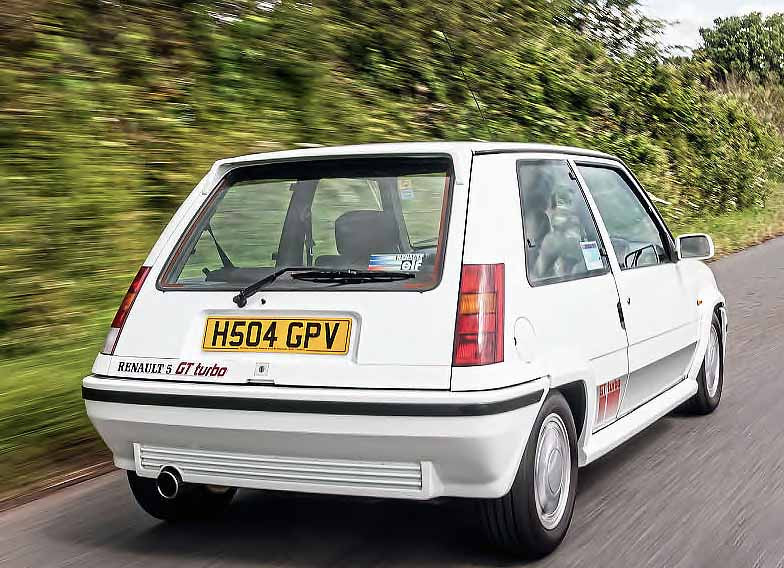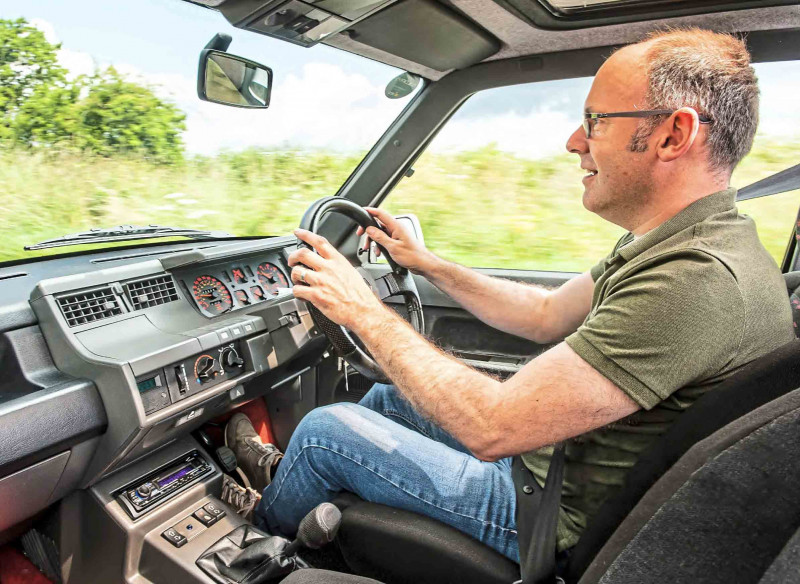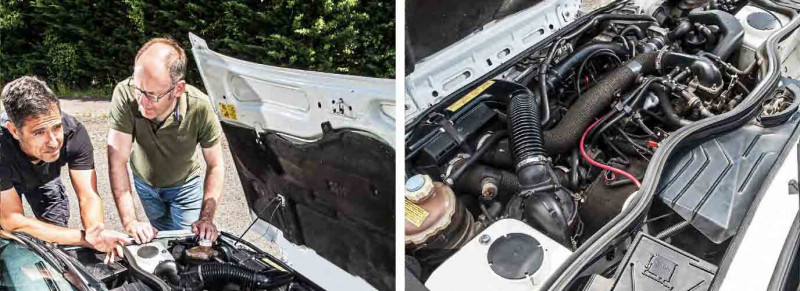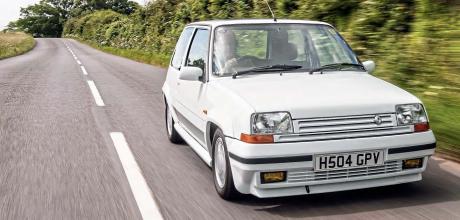1991 Renault 5GT Turbo
Wild insurance premiums put paid to Scotsman Brian Letham’s Renault 5GT Turbo dream in period. Today we make it come true.
‘It’s a potent little thing!’
The List A reader enjoys the Renault 5 GT Turbo he couldn’t insure in the Eighties
It’s often mixed up with its mid-engined, rear-wheel-drive cousins, but there’s no such confusion for today’s chosen reader and self-confessed hot-hatch fan, engineer Brian Letham; for him, it’s all about, and always has been about, the front-wheel-drive Renault 5GT Turbo. ‘I knew what the Turbo 1s and 2s were, but at 17 years old they simply weren’t attainable. That wasn’t the case with the GT Turbo and I desired one enough to at least be frightened off when I looked at insurance, that was the big problem. I was at the wrong age when it went absolutely nuts; these cars were being stolen, joy-ridden and written off at a rate of knots. The classifieds were full of them and to buy one was quite cheap, but I remember being quoted £3000 per year to insure one – that was a mortgage-sized lump of money!’

The in-period fiscals saw his hot-hatch dream shelved, at least until relatively recently when he bought a Peugeot 205GTI 1.9. To get his late-teens driving kicks, Brian went down the classic route in the form of a MkIV Austin-Healey Sprite. ‘The Renault 5GT Turbo has remained an itch that I’ve never scratched,’ he explains as we round a corner together on foot and Simon Byatt’s white, hyper-original Phase 2 comes into view.

‘Oh, would you look at that,’ he says, whistling in appreciation as we approach. ‘I know this is a Nineties example, but the exterior really is pure Eighties – clean and crisp in its execution. The body mouldings add purpose to the car, without creating flabby clutter, and the Turbo badge harks back to a time when a badge conveyed to others what you were driving; these days, roads are filled with a multitude of almost meaningless model designations. I know what he means. ‘Today could end up with the sale of my TVR Cerbera, you know…’
We’re quickly joined by the owner, with talk between the two immediately turning to the shared ground of hot hatches, and particularly those of a French bent, before Simon slides his fingers into the cheeky B-pillar notch that sits just behind the rear edge of the door frame and pops the driver’s door open.

‘I just love that quirky hidden door handle,’ says Brian, climbing into the offered cabin. ‘The interior immediately brings back memories of my parents’ Renault 25, which had the same design language, and some of this switchgear is identical. His eyes find the boost gauge. ‘My inner child certainly likes that, and the Jaeger instruments too. The canopy-shaped covering over the instrument binnacle works well; I think introduction of plastic during the Eighties allowed the wild ideas of the designer to be better translated into reality. The seating position feels well thought out, all-round visibility is excellent thanks to the slender roof pillars, and I love the combination of the red carpets – obligatory uniform for a hot hatch from this period – sports seats, and velour-covered doorcards, which bring a bit of texture to the cabin. That steering wheel is one of the best of its era. Condition-wise, it’s like a time-warp in here; just as it is outside, in fact. It’s nice to see one that doesn’t have cracked bumpers, loads of damage or that hasn’t been Max Power-ed to death. Simon explains, ‘It’s completely standard, save for the lowered springs at the front – only because I couldn’t find standard ones – and a stainless-steel Scorpion exhaust, because the OE one doesn’t sound very good. The paint is almost all original. We can both feel Brian’s anticipation building, so Simon invites him to spark up the petite 1397cc Cleon-Fonte engine. He turns the key, eliciting a momentary, semi-asthmatic burst of noise before it comes to life. ‘Hah, even the starter motor makes a unique sound – on noise alone, a blindfolded car enthusiast of the Eighties could identify this as French. I jump in to join him. ‘The exhaust adds a deep bass note in the cabin,’ he says, ‘but at rest it’s not overly obtrusive with just a nice burble. Will that hold at higher rpm? Only time will tell. We wave au revoir to Simon, and we’re off. ‘Clutch is quite heavy,’ says Brian, engaging first gear then throttle. ‘But gear shift is light. Oh, it comes on boost very nicely. That’s a surprise,’ he says. I caught his quick glance down at the turbo gauge, and his smile – both involuntary – and they’re repeated as he shifts up into second just before the Garrett T2 turbocharger enters its peak range at 3000rpm ‘There’s no ugly torque-less period before the surge comes in, at all. That’s an admirable characteristic, and I’m immediately taken by the fact that it seems to be a much more refined machine than I was expecting. It’s all very intuitive, and I’m acclimatised to the clutch already. The notch-cut gear lever feels comfortable to hand, too. After some rapid straight-line work, Brian’s hard on the brakes, down-shifting as our B-road turns seriously twisty. ‘Brakes are sharp, and effective, and the steering, heavy at low speeds, is lovely to use; we’ve really got used to over-assisted, numb steering of modern cars, but this…’

Conversation, which had to this point flowed quite freely, is suddenly at a premium as my pilot settles down into his driving rhythm. It’s a fair few undulating miles before he’s ready again. ‘The power delivery isn’t wild… I come back to that word, progressive. And I like the addition of that exhaust,’ he says, lowering the window as we approach a long sweeper. ‘Listen to that chatter on the overrun, lovely. Lots of cars are ruined by oversized exhaust pipes, but this one doesn’t abuse your eardrums. The sound is enough to tell you it’s a potent little car, but not some popping, banging and droning monster. A series of sinuous left-rights, followed by an almost right-angle corner, has Brian practically purring. ‘I love too just how tightly the sports seat holds you to it – there’s absolutely no chance of sliding out of it. I don’t think the GT Turbo is quite as sharp as my 205GTI, but it holds its own for sure. With a bit more bravery – and if it were mine – I’d explore its limits a bit more.
We pull into a quiet layby and park up for a more detailed debrief – taking in exterior details. ‘For me it’s the combination of the non-assisted steering, and those,’ he says pointing at the tyres. ‘That really marks out the difference, in terms of how the car drives. Yes, the lack of assistance takes a bit of getting used to initially – you need forward planning at low speed, because it’s almost like you can feel the torsional flex of the steering column – but it’s so feelsome, and faithfully transmits what the tyres are doing to your fingertips. The alloy wheels look tiny by comparison to what we see today and this rubber would have been considered ‘low-profile’ back then but seem hilariously bulbous but they are a part of the GT Turbo’s charm, and actually their larger sections really soak up both irregularities of the road and the occasional cat’s eyes.
We walk round to the rear of the 5. ‘I still love how it looks. In period, so many were slammed, had all sorts of monstrous glassfibre addenda visited upon them, with psychedelic interiors and huge sound systems, but standard is best. My only slight gripe visually, is the rear bumper; for me, it’s a slightly clumsy integration to the rear wings. It’s only a minor detail, one that Renault didn’t get quite right. Other than that, it did a great job. You can say that again. More so, given that by the start of the Nineties the base car was some 18 years old and the engine design, antiquated pushrod- and rocker-operated valves and all, had been on the scene a decade longer. To keep it both visually and mechanically germane, and deliver a retort to Peugeot’s sublime 205GTI, the French manufacturer pulled off a formidable stroke of genius. Yet, this was no minor refresh. Instead, it involved a £400 million investment, with the engine shifting from a traditional north/south arrangement to transverse layout, and the comprehensive chassis reengineering heralding the start of bespoke hot-hatch model engineering, rather than simply ‘hotting up’. Turbocharging, by now in the intake ascendency – and proven in its rear-wheel- drive Turbo 1 and 2 homologation specials – was a natural choice, albeit with 120bhp, rather than their 160bhp, and now driving the front wheels. It’s something Brian’s keen to sample more of, so we climb back aboard. He engages the turbocharger once more, and the little Renault [Want a Drive?] effervesces down the road. ‘With just 820kg to propel, it really does make for urgent progress’. Indeed, 0-60mph in a brisk 7.1sec. We pull into a pub car park, our pre-arranged journey’s end point to meet the awaiting Simon. ‘My only other petrol turbo reference point is a Saab 9-3 Aero I owned, but despite its overtaking prowess you really had to wait for the power to kick in,’ says Brian. Simon replies, ‘I work for Mitsibushi and every time I take the GT Turbo in, the boys there say let’s just whack the turbo boost up a bit. But that did for so many a head gasket.’ ‘For me, it’s perfect as is,’ says Brian. ‘A real survivor. Max Power alone ruined multitudes, and I suspect the attrition rate would have been significantly higher than for 205GTIs. The general refinement of it came as a surprise; I simply did not expect to be describing it this way. From what I knew beforehand I expected it to be in lovely condition but riddled with squeaks and rattles, as per my own 205GTI prior to starting its restoration, and with a frustratingly laggy engine, but it’s the exact opposite. It feels like a really usable, everyday car – in fact, I could quite easily daily it. That highlights just how good an example this is, both in terms of condition and engine set-up. You need to rev the Peugeot more to wring the best pace from its naturally aspirated engine, while the GT Turbo has a purposeful, yet graceful wave of torque always on tap.
Does the 5GT say on his List? ‘Definitely. A nicely sorted example would be an ideal little sports car for a spirited backroad blast, yet still different enough in character to my 205GTI, and equally relatively easy to keep. Without doubt, it stays on it. ‘The French were right on their game in this period, giving us the 5GT Turbo and the 205GTI – it’s the glory days of the hot hatch. Two cars of the same genre that took different routes to make their Nineties culturing motoring masterpieces.
Either way, there’s not much between them.
Thanks to Stephen Dell, the Renault Alpine Owners Club (renaultalpineclub.com)
Rear bumper design aside, our reader remains infatuated. Ross and Brian marvel at the 1.4’s transverse Repositioning. Boost behaviour of the Garrett T2 nothing like Brian expected. Brian recognises some interior elements from his father’s 25. Seat bolsters soon come in useful on Brian’s dream drive. Jaeger dials are a hit with our wide-eyed teen all grown-up. ‘I’m immediately taken by the fact that it seems to be a much more refined machine than I was expecting’
‘I still love how it looks. In period, so many were slammed, but standard is best’
TECHNICAL DATA 1991 Renault 5GT Turbo
- Engine: 1397cc four-cylinder, ohv, Solex carburettor, and Garrett T2 turbocharger
- Max Power: 120bhp @ 5750rpm
- Max Torque: 122lb ft @ 3750rpm
- Transmission: Five-speed manual, front-wheel drive
- Steering: Rack and pinion
- Suspension: Front — independent by MacPherson struts, telescopic dampers, anti-roll bar; Rear — independent by trailing arms, transverse torsion bar, telescopic dampers, anti-roll bar
- Brakes: Discs all round
- Weight: 820kg
- Performance: Top speed: 123mph
- Acceleration 0-60mph: 7.1sec
- Fuel consumption: 23mpg
- Cost new: £7360
- Classic Cars Price Guide: £7000-£20,000


